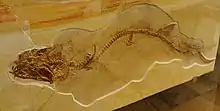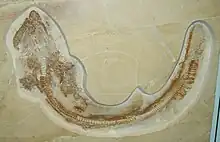Synechodontiformes
Synechodontiformes is an extinct order of prehistoric sharks, known from the Permian to the Paleogene. They are considered to be members of Neoselachii, the group that contains modern sharks and rays. Their placement in the group is uncertain, some authors have considered them to be galeomorph crown-group sharks, while others have considered them to represent a stem-group to modern sharks. They have sometimes been considered a paraphyletic grouping, but Klug (2010) recovered the group as monophyletic. Members of the clade are united by two synapomorphies, "pseudopolyaulacorhize tooth root pattern present; labial root depression in basal view present".[3] The oldest possible member of the clade are teeth from the early Permian (Cisuralian) of the Ural Mountains.[4]
| Synechodontiformes Temporal range: | |
|---|---|
 | |
| Fossil of Sphenodus nitidus | |
 | |
| Paraorthacodus jurensis | |
| Scientific classification | |
| Domain: | Eukaryota |
| Kingdom: | Animalia |
| Phylum: | Chordata |
| Class: | Chondrichthyes |
| Clade: | Neoselachii |
| Order: | †Synechodontiformes Duffin & Ward, 1993[2] |
| Families | |
|
See text | |
Taxonomy
Primarily after Klug (2010)[3]
- †Orthacodontidae de Beaumont, 1960
- †Occitanodus (Guinot, Cappetta & Adnet, 2014). France, Early Cretaceous (Valanginian).[5]
- †Sphenodus (Agassiz, 1843). Early Jurassic to Paleocene.[6]
- †Palaeospinacidae (Regan, 1906).
- †Antrigoulia (Guinot, Cappetta, & Adnet, 2014). Southern France, Early Cretaceous (Valanginian).[5]
- †Palidiplospinax (Klug & Kriwet, 2008). Western England and southern Wales, Late Triassic to Early Jurassic (Rhaetian to Sinemurian, 201-198 Ma).
- †Synechodus (Woodward, 1888) Worldwide distribution, Triassic Period to Eocene.[7]
- †Paraorthacodontidae (Klug, 2010)
- †Macrourogaleus (Fowler, 1947). Southeastern Germany, Late Jurassic (Tithonian, 152-145 Ma).
- †Paraorthacodus (Glikman, 1957). Denmark, Early Jurassic (Pliensbachian, 190-185 Ma).
- Incertae sedis
- †Mucrovenator (Cuny et al., 2001), Northwestern Nevada, USA, Middle Triassic (Anisian, 245 Ma).[8]
- †Polyfaciodus (Koot & Cuny, 2014). Oman, Early Triassic (Olenekian, 251-247 Ma).
- †Rhomphaiodon (Duffin, 1993a). Britain, France, Belgium, Luxembourg, and Germany, Late Triassic to Early Jurassic (Norian to Toarcian, 215-175 Ma).
- †Safrodus (Koot & Cuny, 2014). Oman, Early Triassic (Olenekian, 251-247 Ma).[9] Early Triassic, Oman
References
- "†order Synechodontiformes Duffin and Ward 1993 (elasmobranch)". Fossilworks.
- C. J. Duffin and D. J. Ward. 1993. The Early Jurassic Palaeospinacid sharks of Lyme Regis, southern England. Belgian Geological Survey, Professional Papers, Elasmobranches et Stratigraphie 264:53-102
- Klug, Stefanie (2010). "Monophyly, phylogeny and systematic position of the †Synechodontiformes (Chondrichthyes, Neoselachii)". Zoologica Scripta. 39 (1): 37–49. doi:10.1111/j.1463-6409.2009.00399.x. ISSN 1463-6409. S2CID 85265779.
- Ivanov, Alexander (2005-08-30). "Early Permian chondrichthyans of the Middle and South Urals" (PDF). Revista Brasileira de Paleontologia. 8 (2): 127–138. doi:10.4072/rbp.2005.2.05.
- Guinot, Guillaume; Cappetta, Henri; Adnet, Sylvain (March 2014). "A rare elasmobranch assemblage from the Valanginian (Lower Cretaceous) of southern France". Cretaceous Research. 48: 54–84. doi:10.1016/j.cretres.2013.11.014.
- Kanno, Shiori; Nakajima, Yasuhisa; Hikida, Yoshinori; Sato, Tamaki (2017-04-01). "Sphenodus (Chondrichthyes, Neoselachii) from the Upper Cretaceous in Nakagawa Town, Hokkaido, Japan". Paleontological Research. 21 (2): 122. doi:10.2517/2016PR009. ISSN 1342-8144. S2CID 133054888.
- Batchelor, Trevor J.; Duffin, Christopher J. (August 2020). "First description of sharks' teeth from the Ferruginous Sands Formation (Aptian, Early Cretaceous) of the Isle of Wight". Proceedings of the Geologists' Association. 131 (3–4): 353–359. doi:10.1016/j.pgeola.2019.06.004. S2CID 199107658.
- https://www.mindat.org/taxon-P162123.html
- Koot, Martha B.; Cuny, Gilles; Orchard, Michael J.; Richoz, Sylvain; Hart, Malcolm B.; Twitchett, Richard J. (2015-10-03). "New hybodontiform and neoselachian sharks from the Lower Triassic of Oman". Journal of Systematic Palaeontology. 13 (10): 891–917. doi:10.1080/14772019.2014.963179. ISSN 1477-2019. S2CID 129741739.
External links
 Data related to Synechodontiformes at Wikispecies
Data related to Synechodontiformes at Wikispecies Media related to Synechodontiformes at Wikimedia Commons
Media related to Synechodontiformes at Wikimedia Commons